Report: Financial Performance Analysis of Aston Villa PLC (Finance)
VerifiedAdded on 2020/10/22
|13
|2531
|410
Report
AI Summary
This report provides a comprehensive analysis of Aston Villa PLC's financial performance. It begins with an introduction to financial performance and its significance, followed by an examination of the company's non-current assets, liabilities, and equity. The report then delves into the impact of depreciation variations on profit and interprets the cash flow statement, highlighting the absence of a prepared cash flow statement by the company. Ratio analysis, including current ratio, quick ratio, debt-equity ratio, return on assets, debtor turnover ratio, and net profit margin ratio, is conducted to assess the company's financial health. The report compares the financial statements of limited companies with sole proprietorships and partnerships, emphasizing key differences. Finally, it discusses the commitments of Aston Villa PLC and their potential impact on the company's finances, concluding that the club's performance is not good and is financially weak. The report utilizes data from 2015 to 2017 to support its analysis.
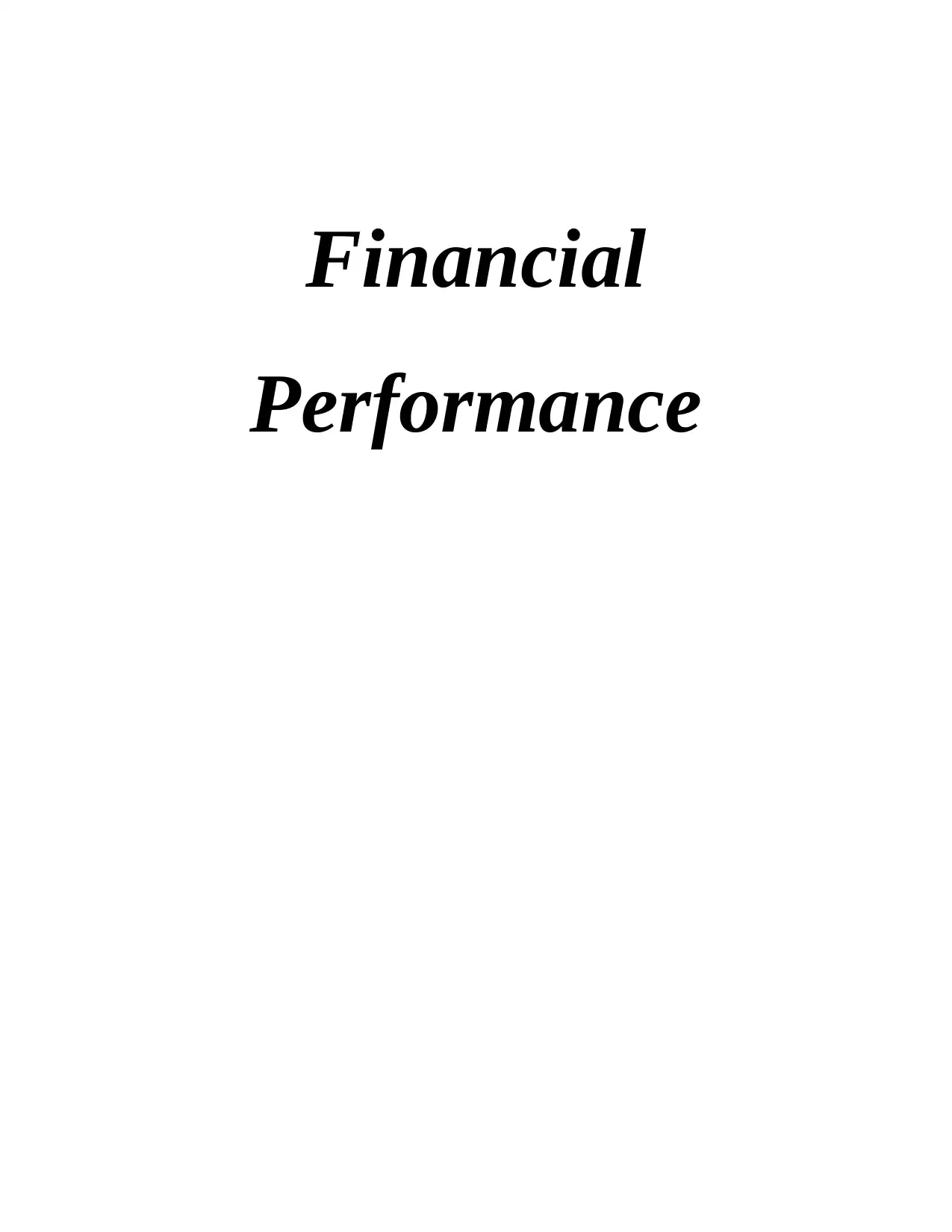
Financial
Performance
Performance
Paraphrase This Document
Need a fresh take? Get an instant paraphrase of this document with our AI Paraphraser
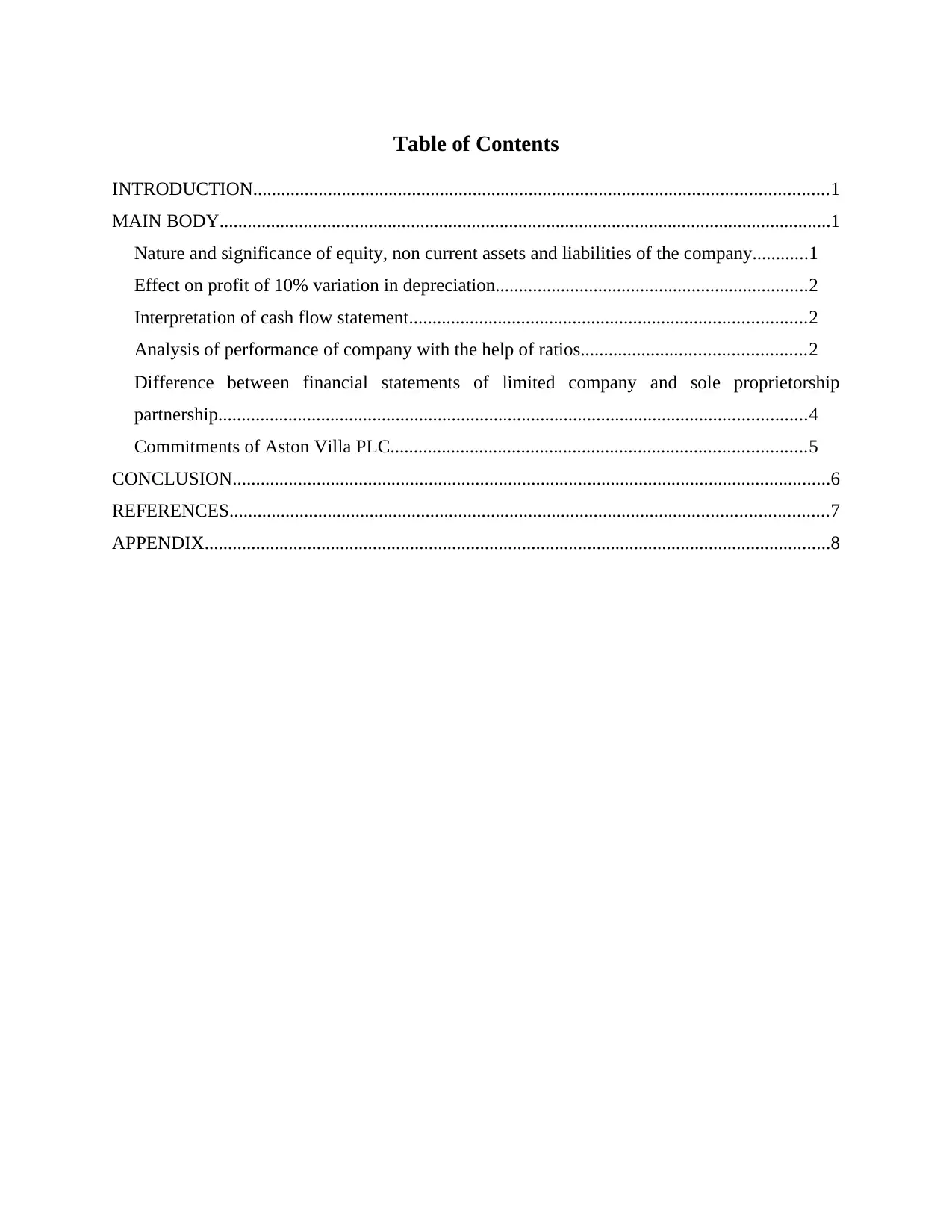
Table of Contents
INTRODUCTION...........................................................................................................................1
MAIN BODY...................................................................................................................................1
Nature and significance of equity, non current assets and liabilities of the company............1
Effect on profit of 10% variation in depreciation...................................................................2
Interpretation of cash flow statement.....................................................................................2
Analysis of performance of company with the help of ratios................................................2
Difference between financial statements of limited company and sole proprietorship
partnership..............................................................................................................................4
Commitments of Aston Villa PLC.........................................................................................5
CONCLUSION................................................................................................................................6
REFERENCES................................................................................................................................7
APPENDIX......................................................................................................................................8
INTRODUCTION...........................................................................................................................1
MAIN BODY...................................................................................................................................1
Nature and significance of equity, non current assets and liabilities of the company............1
Effect on profit of 10% variation in depreciation...................................................................2
Interpretation of cash flow statement.....................................................................................2
Analysis of performance of company with the help of ratios................................................2
Difference between financial statements of limited company and sole proprietorship
partnership..............................................................................................................................4
Commitments of Aston Villa PLC.........................................................................................5
CONCLUSION................................................................................................................................6
REFERENCES................................................................................................................................7
APPENDIX......................................................................................................................................8
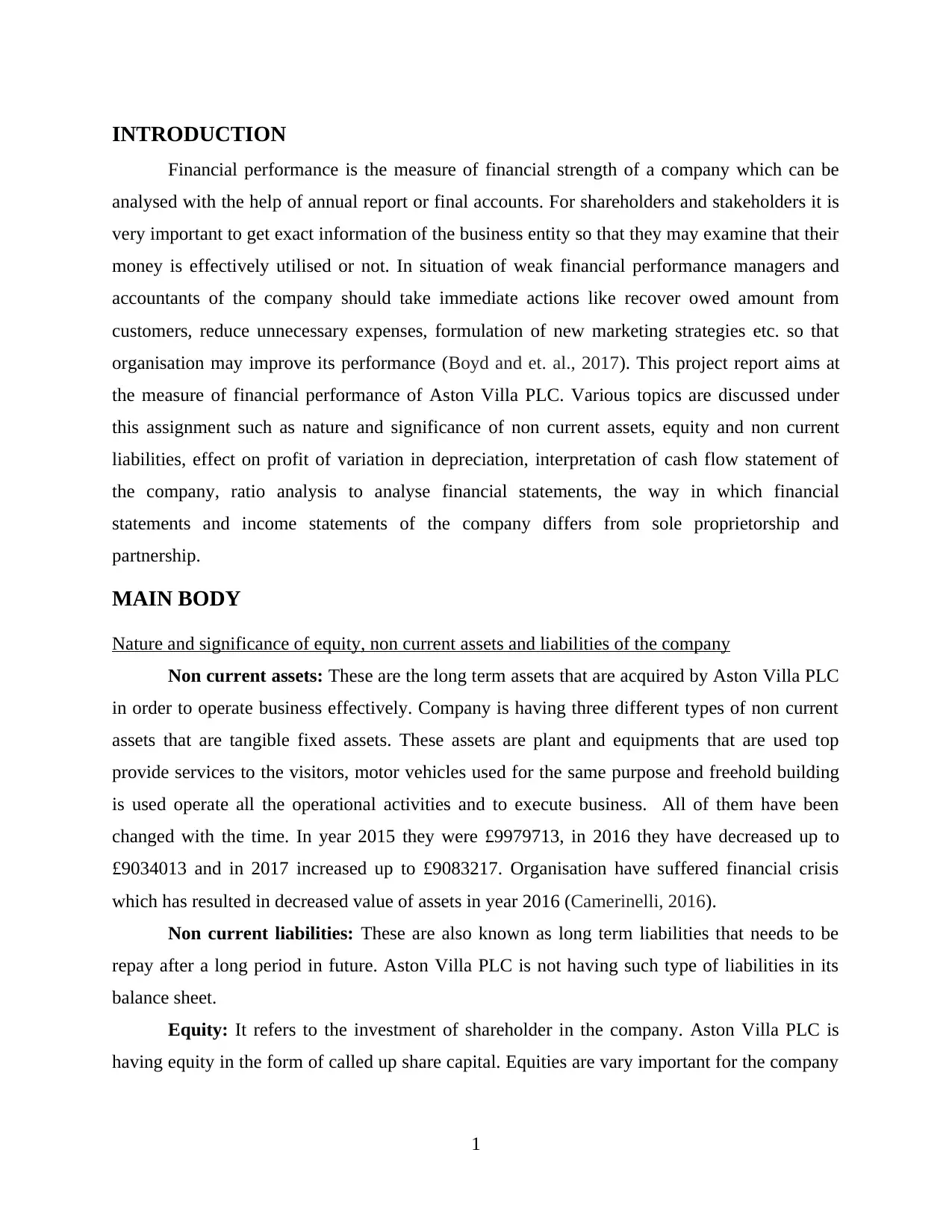
INTRODUCTION
Financial performance is the measure of financial strength of a company which can be
analysed with the help of annual report or final accounts. For shareholders and stakeholders it is
very important to get exact information of the business entity so that they may examine that their
money is effectively utilised or not. In situation of weak financial performance managers and
accountants of the company should take immediate actions like recover owed amount from
customers, reduce unnecessary expenses, formulation of new marketing strategies etc. so that
organisation may improve its performance (Boyd and et. al., 2017). This project report aims at
the measure of financial performance of Aston Villa PLC. Various topics are discussed under
this assignment such as nature and significance of non current assets, equity and non current
liabilities, effect on profit of variation in depreciation, interpretation of cash flow statement of
the company, ratio analysis to analyse financial statements, the way in which financial
statements and income statements of the company differs from sole proprietorship and
partnership.
MAIN BODY
Nature and significance of equity, non current assets and liabilities of the company
Non current assets: These are the long term assets that are acquired by Aston Villa PLC
in order to operate business effectively. Company is having three different types of non current
assets that are tangible fixed assets. These assets are plant and equipments that are used top
provide services to the visitors, motor vehicles used for the same purpose and freehold building
is used operate all the operational activities and to execute business. All of them have been
changed with the time. In year 2015 they were £9979713, in 2016 they have decreased up to
£9034013 and in 2017 increased up to £9083217. Organisation have suffered financial crisis
which has resulted in decreased value of assets in year 2016 (Camerinelli, 2016).
Non current liabilities: These are also known as long term liabilities that needs to be
repay after a long period in future. Aston Villa PLC is not having such type of liabilities in its
balance sheet.
Equity: It refers to the investment of shareholder in the company. Aston Villa PLC is
having equity in the form of called up share capital. Equities are vary important for the company
1
Financial performance is the measure of financial strength of a company which can be
analysed with the help of annual report or final accounts. For shareholders and stakeholders it is
very important to get exact information of the business entity so that they may examine that their
money is effectively utilised or not. In situation of weak financial performance managers and
accountants of the company should take immediate actions like recover owed amount from
customers, reduce unnecessary expenses, formulation of new marketing strategies etc. so that
organisation may improve its performance (Boyd and et. al., 2017). This project report aims at
the measure of financial performance of Aston Villa PLC. Various topics are discussed under
this assignment such as nature and significance of non current assets, equity and non current
liabilities, effect on profit of variation in depreciation, interpretation of cash flow statement of
the company, ratio analysis to analyse financial statements, the way in which financial
statements and income statements of the company differs from sole proprietorship and
partnership.
MAIN BODY
Nature and significance of equity, non current assets and liabilities of the company
Non current assets: These are the long term assets that are acquired by Aston Villa PLC
in order to operate business effectively. Company is having three different types of non current
assets that are tangible fixed assets. These assets are plant and equipments that are used top
provide services to the visitors, motor vehicles used for the same purpose and freehold building
is used operate all the operational activities and to execute business. All of them have been
changed with the time. In year 2015 they were £9979713, in 2016 they have decreased up to
£9034013 and in 2017 increased up to £9083217. Organisation have suffered financial crisis
which has resulted in decreased value of assets in year 2016 (Camerinelli, 2016).
Non current liabilities: These are also known as long term liabilities that needs to be
repay after a long period in future. Aston Villa PLC is not having such type of liabilities in its
balance sheet.
Equity: It refers to the investment of shareholder in the company. Aston Villa PLC is
having equity in the form of called up share capital. Equities are vary important for the company
1
⊘ This is a preview!⊘
Do you want full access?
Subscribe today to unlock all pages.

Trusted by 1+ million students worldwide
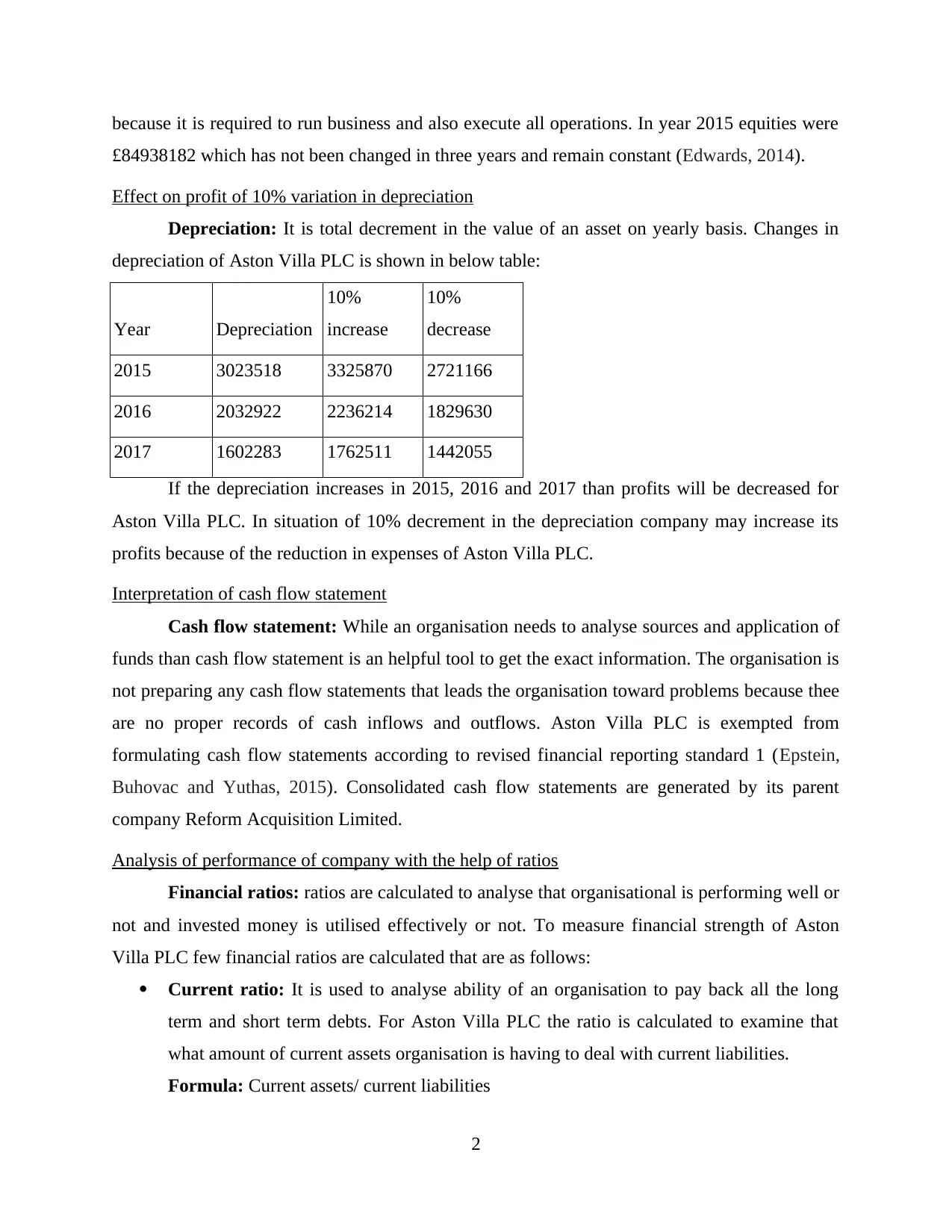
because it is required to run business and also execute all operations. In year 2015 equities were
£84938182 which has not been changed in three years and remain constant (Edwards, 2014).
Effect on profit of 10% variation in depreciation
Depreciation: It is total decrement in the value of an asset on yearly basis. Changes in
depreciation of Aston Villa PLC is shown in below table:
Year Depreciation
10%
increase
10%
decrease
2015 3023518 3325870 2721166
2016 2032922 2236214 1829630
2017 1602283 1762511 1442055
If the depreciation increases in 2015, 2016 and 2017 than profits will be decreased for
Aston Villa PLC. In situation of 10% decrement in the depreciation company may increase its
profits because of the reduction in expenses of Aston Villa PLC.
Interpretation of cash flow statement
Cash flow statement: While an organisation needs to analyse sources and application of
funds than cash flow statement is an helpful tool to get the exact information. The organisation is
not preparing any cash flow statements that leads the organisation toward problems because thee
are no proper records of cash inflows and outflows. Aston Villa PLC is exempted from
formulating cash flow statements according to revised financial reporting standard 1 (Epstein,
Buhovac and Yuthas, 2015). Consolidated cash flow statements are generated by its parent
company Reform Acquisition Limited.
Analysis of performance of company with the help of ratios
Financial ratios: ratios are calculated to analyse that organisational is performing well or
not and invested money is utilised effectively or not. To measure financial strength of Aston
Villa PLC few financial ratios are calculated that are as follows:
Current ratio: It is used to analyse ability of an organisation to pay back all the long
term and short term debts. For Aston Villa PLC the ratio is calculated to examine that
what amount of current assets organisation is having to deal with current liabilities.
Formula: Current assets/ current liabilities
2
£84938182 which has not been changed in three years and remain constant (Edwards, 2014).
Effect on profit of 10% variation in depreciation
Depreciation: It is total decrement in the value of an asset on yearly basis. Changes in
depreciation of Aston Villa PLC is shown in below table:
Year Depreciation
10%
increase
10%
decrease
2015 3023518 3325870 2721166
2016 2032922 2236214 1829630
2017 1602283 1762511 1442055
If the depreciation increases in 2015, 2016 and 2017 than profits will be decreased for
Aston Villa PLC. In situation of 10% decrement in the depreciation company may increase its
profits because of the reduction in expenses of Aston Villa PLC.
Interpretation of cash flow statement
Cash flow statement: While an organisation needs to analyse sources and application of
funds than cash flow statement is an helpful tool to get the exact information. The organisation is
not preparing any cash flow statements that leads the organisation toward problems because thee
are no proper records of cash inflows and outflows. Aston Villa PLC is exempted from
formulating cash flow statements according to revised financial reporting standard 1 (Epstein,
Buhovac and Yuthas, 2015). Consolidated cash flow statements are generated by its parent
company Reform Acquisition Limited.
Analysis of performance of company with the help of ratios
Financial ratios: ratios are calculated to analyse that organisational is performing well or
not and invested money is utilised effectively or not. To measure financial strength of Aston
Villa PLC few financial ratios are calculated that are as follows:
Current ratio: It is used to analyse ability of an organisation to pay back all the long
term and short term debts. For Aston Villa PLC the ratio is calculated to examine that
what amount of current assets organisation is having to deal with current liabilities.
Formula: Current assets/ current liabilities
2
Paraphrase This Document
Need a fresh take? Get an instant paraphrase of this document with our AI Paraphraser
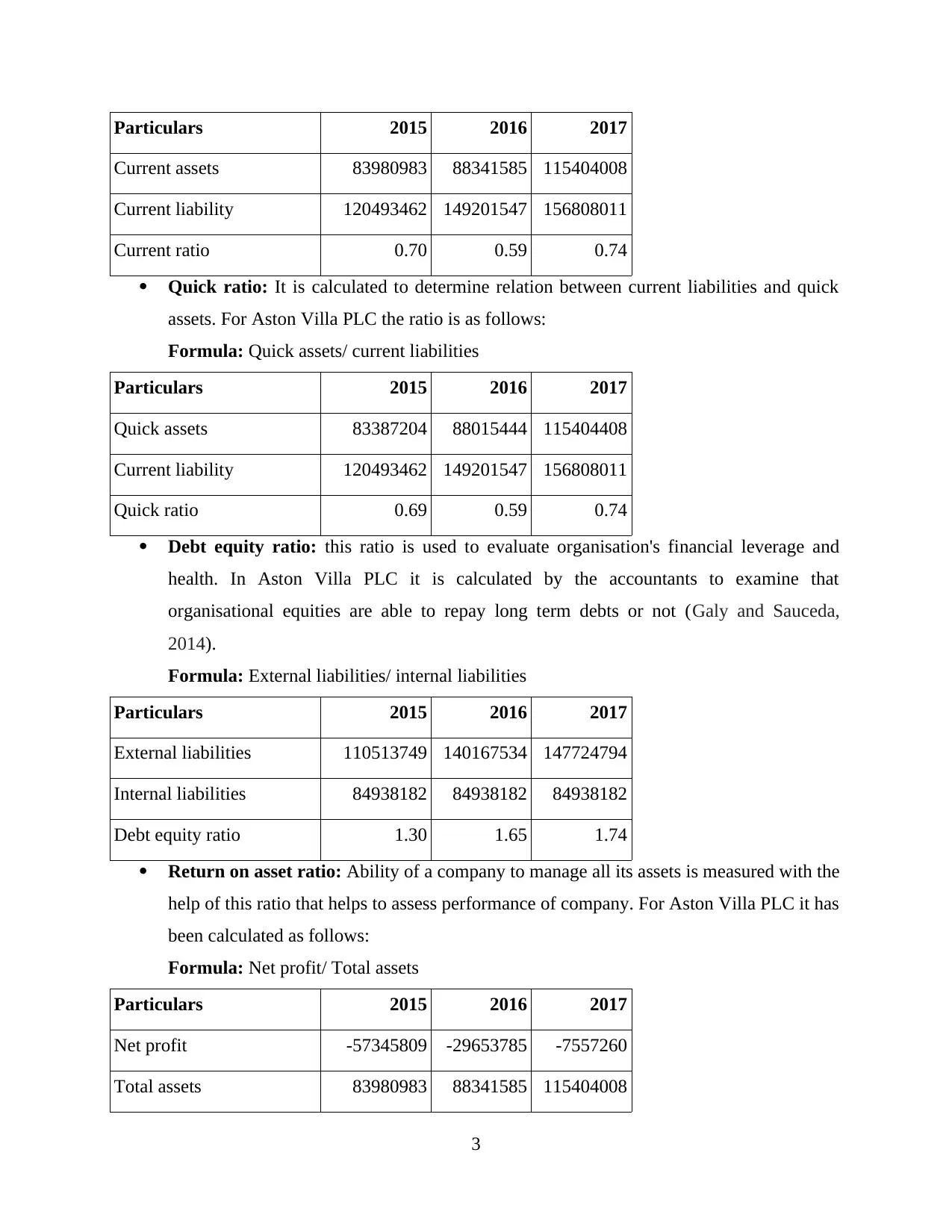
Particulars 2015 2016 2017
Current assets 83980983 88341585 115404008
Current liability 120493462 149201547 156808011
Current ratio 0.70 0.59 0.74
Quick ratio: It is calculated to determine relation between current liabilities and quick
assets. For Aston Villa PLC the ratio is as follows:
Formula: Quick assets/ current liabilities
Particulars 2015 2016 2017
Quick assets 83387204 88015444 115404408
Current liability 120493462 149201547 156808011
Quick ratio 0.69 0.59 0.74
Debt equity ratio: this ratio is used to evaluate organisation's financial leverage and
health. In Aston Villa PLC it is calculated by the accountants to examine that
organisational equities are able to repay long term debts or not (Galy and Sauceda,
2014).
Formula: External liabilities/ internal liabilities
Particulars 2015 2016 2017
External liabilities 110513749 140167534 147724794
Internal liabilities 84938182 84938182 84938182
Debt equity ratio 1.30 1.65 1.74
Return on asset ratio: Ability of a company to manage all its assets is measured with the
help of this ratio that helps to assess performance of company. For Aston Villa PLC it has
been calculated as follows:
Formula: Net profit/ Total assets
Particulars 2015 2016 2017
Net profit -57345809 -29653785 -7557260
Total assets 83980983 88341585 115404008
3
Current assets 83980983 88341585 115404008
Current liability 120493462 149201547 156808011
Current ratio 0.70 0.59 0.74
Quick ratio: It is calculated to determine relation between current liabilities and quick
assets. For Aston Villa PLC the ratio is as follows:
Formula: Quick assets/ current liabilities
Particulars 2015 2016 2017
Quick assets 83387204 88015444 115404408
Current liability 120493462 149201547 156808011
Quick ratio 0.69 0.59 0.74
Debt equity ratio: this ratio is used to evaluate organisation's financial leverage and
health. In Aston Villa PLC it is calculated by the accountants to examine that
organisational equities are able to repay long term debts or not (Galy and Sauceda,
2014).
Formula: External liabilities/ internal liabilities
Particulars 2015 2016 2017
External liabilities 110513749 140167534 147724794
Internal liabilities 84938182 84938182 84938182
Debt equity ratio 1.30 1.65 1.74
Return on asset ratio: Ability of a company to manage all its assets is measured with the
help of this ratio that helps to assess performance of company. For Aston Villa PLC it has
been calculated as follows:
Formula: Net profit/ Total assets
Particulars 2015 2016 2017
Net profit -57345809 -29653785 -7557260
Total assets 83980983 88341585 115404008
3
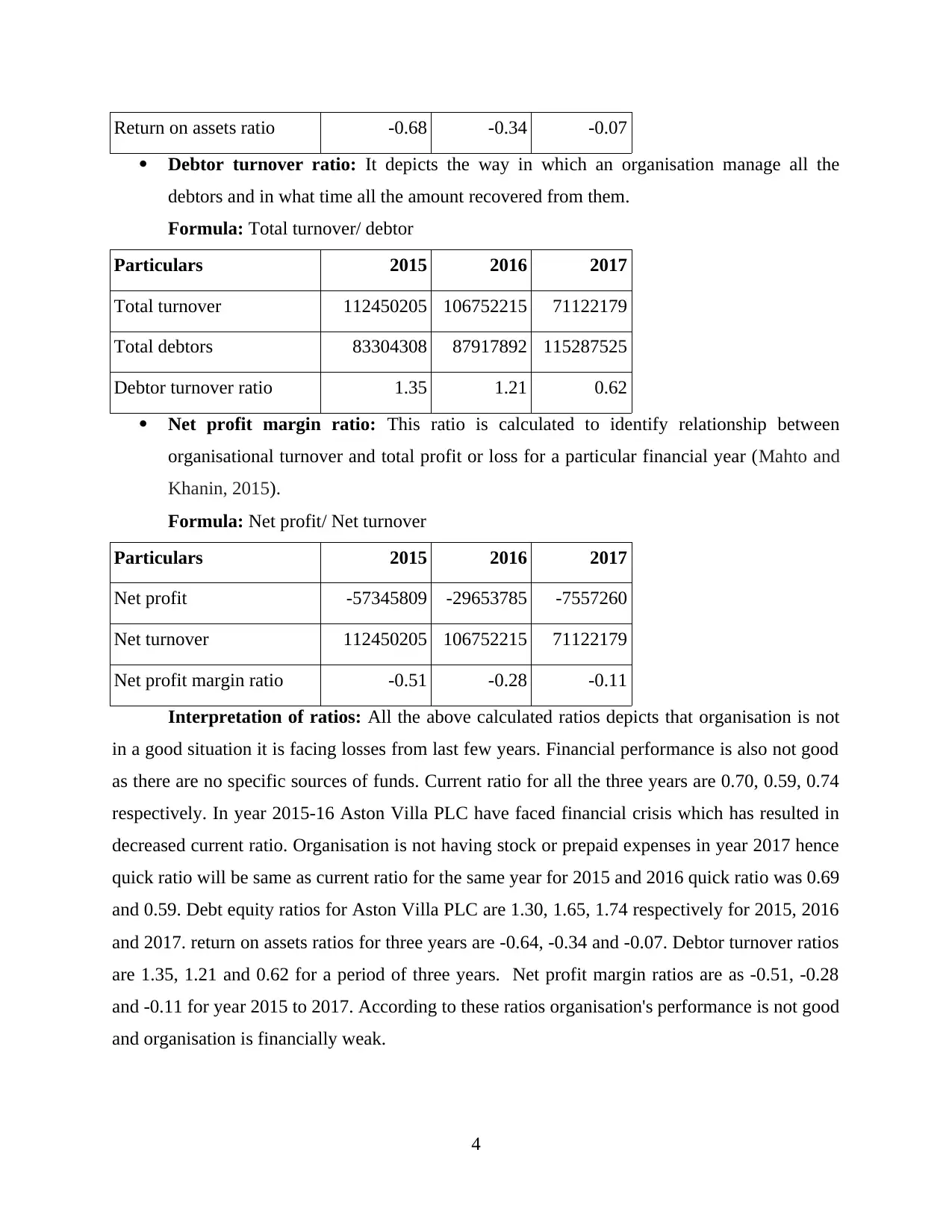
Return on assets ratio -0.68 -0.34 -0.07
Debtor turnover ratio: It depicts the way in which an organisation manage all the
debtors and in what time all the amount recovered from them.
Formula: Total turnover/ debtor
Particulars 2015 2016 2017
Total turnover 112450205 106752215 71122179
Total debtors 83304308 87917892 115287525
Debtor turnover ratio 1.35 1.21 0.62
Net profit margin ratio: This ratio is calculated to identify relationship between
organisational turnover and total profit or loss for a particular financial year (Mahto and
Khanin, 2015).
Formula: Net profit/ Net turnover
Particulars 2015 2016 2017
Net profit -57345809 -29653785 -7557260
Net turnover 112450205 106752215 71122179
Net profit margin ratio -0.51 -0.28 -0.11
Interpretation of ratios: All the above calculated ratios depicts that organisation is not
in a good situation it is facing losses from last few years. Financial performance is also not good
as there are no specific sources of funds. Current ratio for all the three years are 0.70, 0.59, 0.74
respectively. In year 2015-16 Aston Villa PLC have faced financial crisis which has resulted in
decreased current ratio. Organisation is not having stock or prepaid expenses in year 2017 hence
quick ratio will be same as current ratio for the same year for 2015 and 2016 quick ratio was 0.69
and 0.59. Debt equity ratios for Aston Villa PLC are 1.30, 1.65, 1.74 respectively for 2015, 2016
and 2017. return on assets ratios for three years are -0.64, -0.34 and -0.07. Debtor turnover ratios
are 1.35, 1.21 and 0.62 for a period of three years. Net profit margin ratios are as -0.51, -0.28
and -0.11 for year 2015 to 2017. According to these ratios organisation's performance is not good
and organisation is financially weak.
4
Debtor turnover ratio: It depicts the way in which an organisation manage all the
debtors and in what time all the amount recovered from them.
Formula: Total turnover/ debtor
Particulars 2015 2016 2017
Total turnover 112450205 106752215 71122179
Total debtors 83304308 87917892 115287525
Debtor turnover ratio 1.35 1.21 0.62
Net profit margin ratio: This ratio is calculated to identify relationship between
organisational turnover and total profit or loss for a particular financial year (Mahto and
Khanin, 2015).
Formula: Net profit/ Net turnover
Particulars 2015 2016 2017
Net profit -57345809 -29653785 -7557260
Net turnover 112450205 106752215 71122179
Net profit margin ratio -0.51 -0.28 -0.11
Interpretation of ratios: All the above calculated ratios depicts that organisation is not
in a good situation it is facing losses from last few years. Financial performance is also not good
as there are no specific sources of funds. Current ratio for all the three years are 0.70, 0.59, 0.74
respectively. In year 2015-16 Aston Villa PLC have faced financial crisis which has resulted in
decreased current ratio. Organisation is not having stock or prepaid expenses in year 2017 hence
quick ratio will be same as current ratio for the same year for 2015 and 2016 quick ratio was 0.69
and 0.59. Debt equity ratios for Aston Villa PLC are 1.30, 1.65, 1.74 respectively for 2015, 2016
and 2017. return on assets ratios for three years are -0.64, -0.34 and -0.07. Debtor turnover ratios
are 1.35, 1.21 and 0.62 for a period of three years. Net profit margin ratios are as -0.51, -0.28
and -0.11 for year 2015 to 2017. According to these ratios organisation's performance is not good
and organisation is financially weak.
4
⊘ This is a preview!⊘
Do you want full access?
Subscribe today to unlock all pages.

Trusted by 1+ million students worldwide
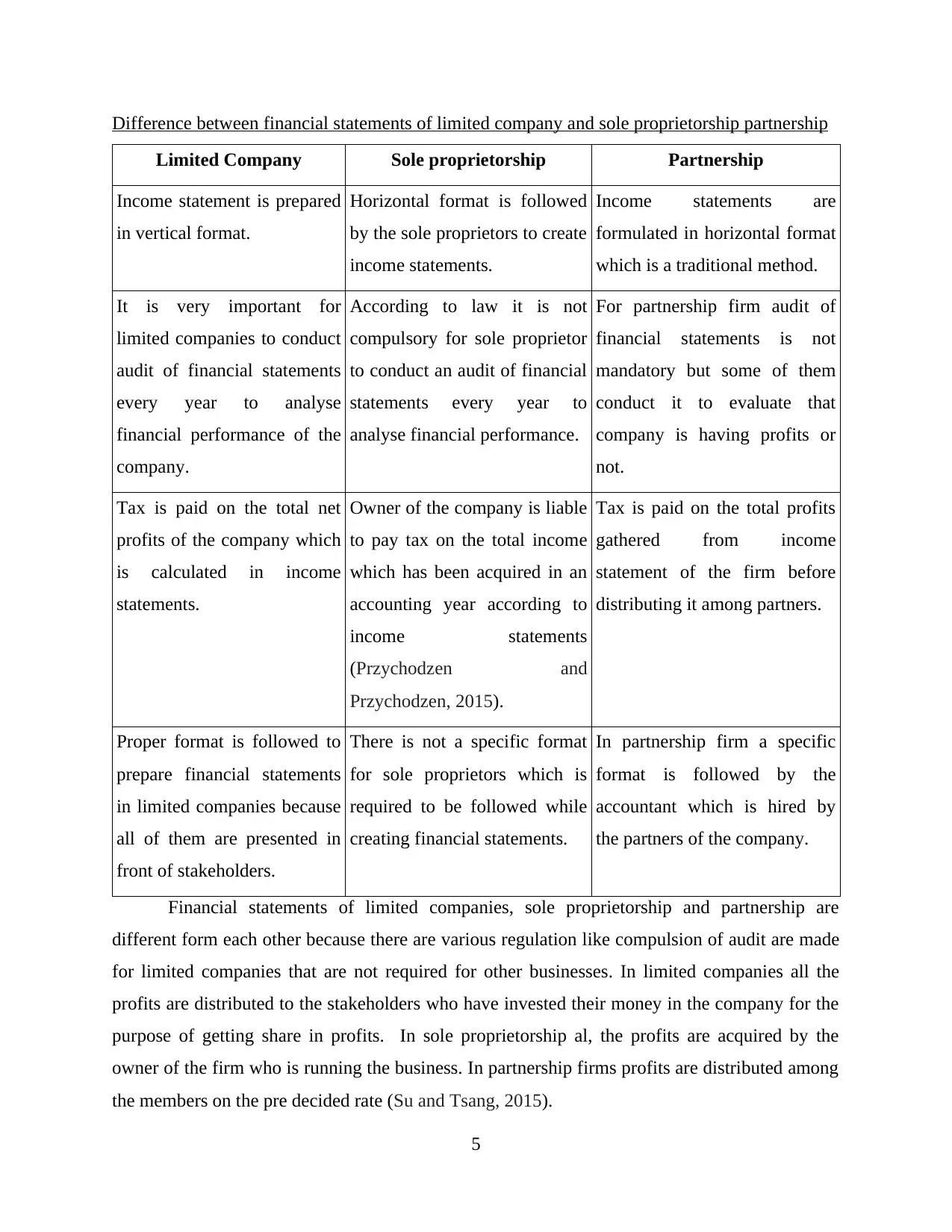
Difference between financial statements of limited company and sole proprietorship partnership
Limited Company Sole proprietorship Partnership
Income statement is prepared
in vertical format.
Horizontal format is followed
by the sole proprietors to create
income statements.
Income statements are
formulated in horizontal format
which is a traditional method.
It is very important for
limited companies to conduct
audit of financial statements
every year to analyse
financial performance of the
company.
According to law it is not
compulsory for sole proprietor
to conduct an audit of financial
statements every year to
analyse financial performance.
For partnership firm audit of
financial statements is not
mandatory but some of them
conduct it to evaluate that
company is having profits or
not.
Tax is paid on the total net
profits of the company which
is calculated in income
statements.
Owner of the company is liable
to pay tax on the total income
which has been acquired in an
accounting year according to
income statements
(Przychodzen and
Przychodzen, 2015).
Tax is paid on the total profits
gathered from income
statement of the firm before
distributing it among partners.
Proper format is followed to
prepare financial statements
in limited companies because
all of them are presented in
front of stakeholders.
There is not a specific format
for sole proprietors which is
required to be followed while
creating financial statements.
In partnership firm a specific
format is followed by the
accountant which is hired by
the partners of the company.
Financial statements of limited companies, sole proprietorship and partnership are
different form each other because there are various regulation like compulsion of audit are made
for limited companies that are not required for other businesses. In limited companies all the
profits are distributed to the stakeholders who have invested their money in the company for the
purpose of getting share in profits. In sole proprietorship al, the profits are acquired by the
owner of the firm who is running the business. In partnership firms profits are distributed among
the members on the pre decided rate (Su and Tsang, 2015).
5
Limited Company Sole proprietorship Partnership
Income statement is prepared
in vertical format.
Horizontal format is followed
by the sole proprietors to create
income statements.
Income statements are
formulated in horizontal format
which is a traditional method.
It is very important for
limited companies to conduct
audit of financial statements
every year to analyse
financial performance of the
company.
According to law it is not
compulsory for sole proprietor
to conduct an audit of financial
statements every year to
analyse financial performance.
For partnership firm audit of
financial statements is not
mandatory but some of them
conduct it to evaluate that
company is having profits or
not.
Tax is paid on the total net
profits of the company which
is calculated in income
statements.
Owner of the company is liable
to pay tax on the total income
which has been acquired in an
accounting year according to
income statements
(Przychodzen and
Przychodzen, 2015).
Tax is paid on the total profits
gathered from income
statement of the firm before
distributing it among partners.
Proper format is followed to
prepare financial statements
in limited companies because
all of them are presented in
front of stakeholders.
There is not a specific format
for sole proprietors which is
required to be followed while
creating financial statements.
In partnership firm a specific
format is followed by the
accountant which is hired by
the partners of the company.
Financial statements of limited companies, sole proprietorship and partnership are
different form each other because there are various regulation like compulsion of audit are made
for limited companies that are not required for other businesses. In limited companies all the
profits are distributed to the stakeholders who have invested their money in the company for the
purpose of getting share in profits. In sole proprietorship al, the profits are acquired by the
owner of the firm who is running the business. In partnership firms profits are distributed among
the members on the pre decided rate (Su and Tsang, 2015).
5
Paraphrase This Document
Need a fresh take? Get an instant paraphrase of this document with our AI Paraphraser
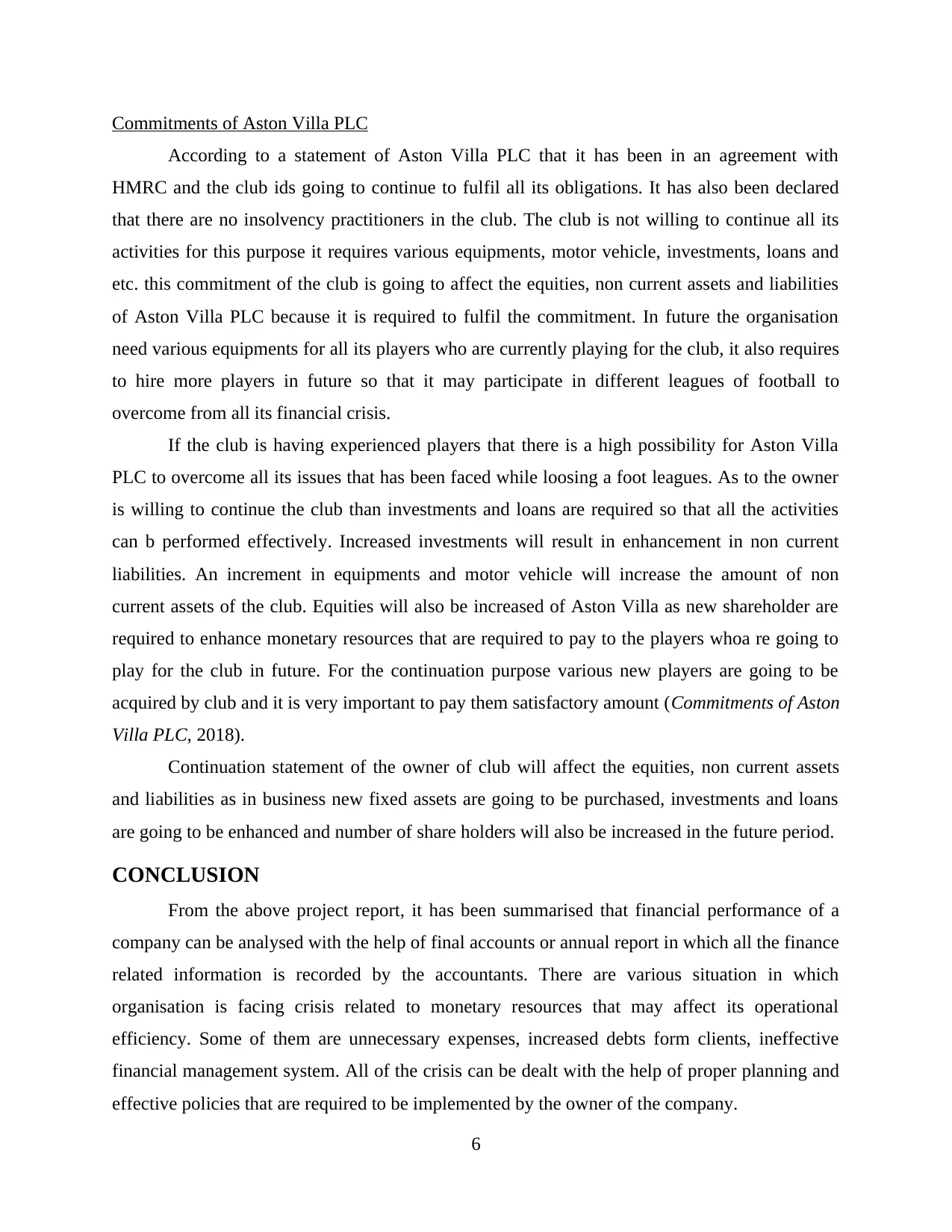
Commitments of Aston Villa PLC
According to a statement of Aston Villa PLC that it has been in an agreement with
HMRC and the club ids going to continue to fulfil all its obligations. It has also been declared
that there are no insolvency practitioners in the club. The club is not willing to continue all its
activities for this purpose it requires various equipments, motor vehicle, investments, loans and
etc. this commitment of the club is going to affect the equities, non current assets and liabilities
of Aston Villa PLC because it is required to fulfil the commitment. In future the organisation
need various equipments for all its players who are currently playing for the club, it also requires
to hire more players in future so that it may participate in different leagues of football to
overcome from all its financial crisis.
If the club is having experienced players that there is a high possibility for Aston Villa
PLC to overcome all its issues that has been faced while loosing a foot leagues. As to the owner
is willing to continue the club than investments and loans are required so that all the activities
can b performed effectively. Increased investments will result in enhancement in non current
liabilities. An increment in equipments and motor vehicle will increase the amount of non
current assets of the club. Equities will also be increased of Aston Villa as new shareholder are
required to enhance monetary resources that are required to pay to the players whoa re going to
play for the club in future. For the continuation purpose various new players are going to be
acquired by club and it is very important to pay them satisfactory amount (Commitments of Aston
Villa PLC, 2018).
Continuation statement of the owner of club will affect the equities, non current assets
and liabilities as in business new fixed assets are going to be purchased, investments and loans
are going to be enhanced and number of share holders will also be increased in the future period.
CONCLUSION
From the above project report, it has been summarised that financial performance of a
company can be analysed with the help of final accounts or annual report in which all the finance
related information is recorded by the accountants. There are various situation in which
organisation is facing crisis related to monetary resources that may affect its operational
efficiency. Some of them are unnecessary expenses, increased debts form clients, ineffective
financial management system. All of the crisis can be dealt with the help of proper planning and
effective policies that are required to be implemented by the owner of the company.
6
According to a statement of Aston Villa PLC that it has been in an agreement with
HMRC and the club ids going to continue to fulfil all its obligations. It has also been declared
that there are no insolvency practitioners in the club. The club is not willing to continue all its
activities for this purpose it requires various equipments, motor vehicle, investments, loans and
etc. this commitment of the club is going to affect the equities, non current assets and liabilities
of Aston Villa PLC because it is required to fulfil the commitment. In future the organisation
need various equipments for all its players who are currently playing for the club, it also requires
to hire more players in future so that it may participate in different leagues of football to
overcome from all its financial crisis.
If the club is having experienced players that there is a high possibility for Aston Villa
PLC to overcome all its issues that has been faced while loosing a foot leagues. As to the owner
is willing to continue the club than investments and loans are required so that all the activities
can b performed effectively. Increased investments will result in enhancement in non current
liabilities. An increment in equipments and motor vehicle will increase the amount of non
current assets of the club. Equities will also be increased of Aston Villa as new shareholder are
required to enhance monetary resources that are required to pay to the players whoa re going to
play for the club in future. For the continuation purpose various new players are going to be
acquired by club and it is very important to pay them satisfactory amount (Commitments of Aston
Villa PLC, 2018).
Continuation statement of the owner of club will affect the equities, non current assets
and liabilities as in business new fixed assets are going to be purchased, investments and loans
are going to be enhanced and number of share holders will also be increased in the future period.
CONCLUSION
From the above project report, it has been summarised that financial performance of a
company can be analysed with the help of final accounts or annual report in which all the finance
related information is recorded by the accountants. There are various situation in which
organisation is facing crisis related to monetary resources that may affect its operational
efficiency. Some of them are unnecessary expenses, increased debts form clients, ineffective
financial management system. All of the crisis can be dealt with the help of proper planning and
effective policies that are required to be implemented by the owner of the company.
6

7
⊘ This is a preview!⊘
Do you want full access?
Subscribe today to unlock all pages.

Trusted by 1+ million students worldwide
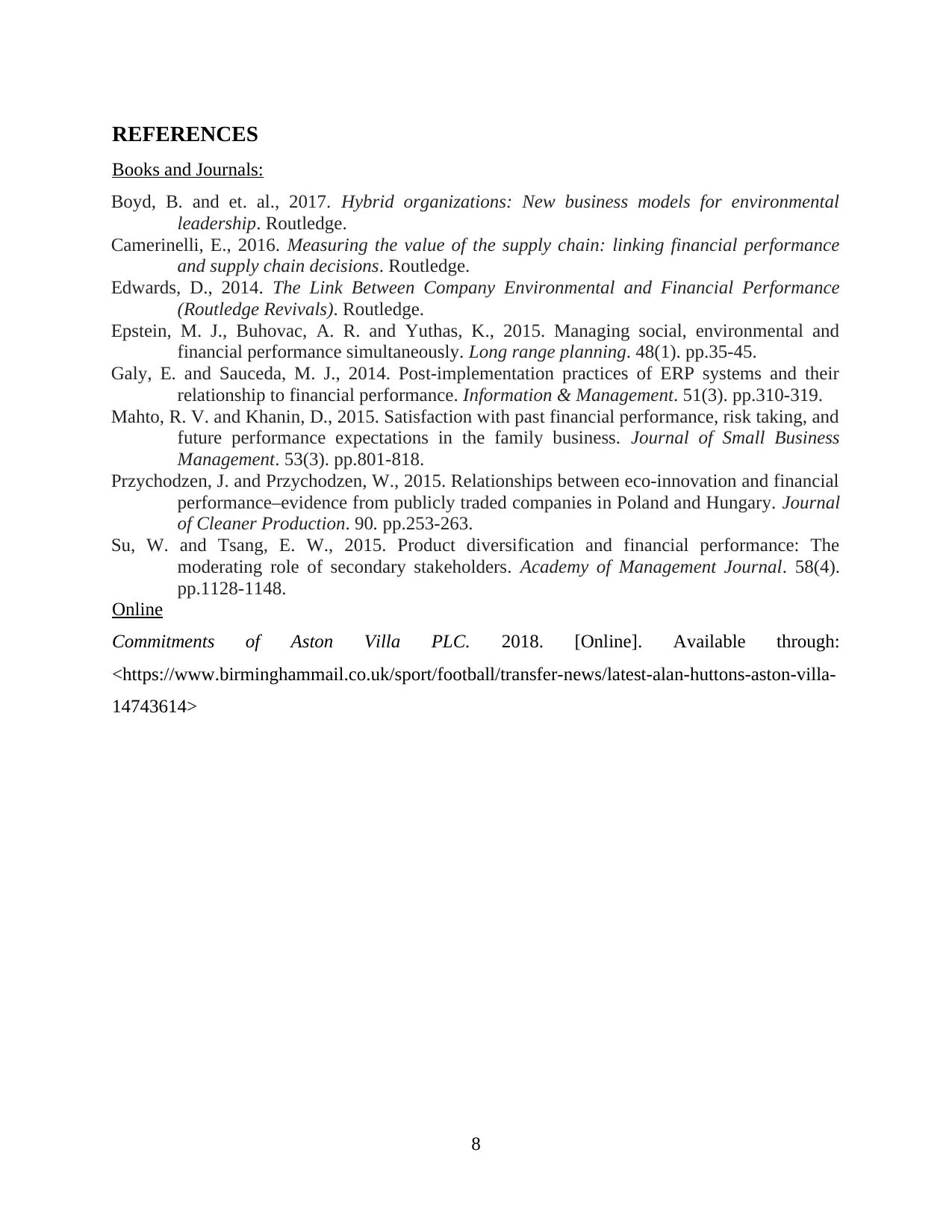
REFERENCES
Books and Journals:
Boyd, B. and et. al., 2017. Hybrid organizations: New business models for environmental
leadership. Routledge.
Camerinelli, E., 2016. Measuring the value of the supply chain: linking financial performance
and supply chain decisions. Routledge.
Edwards, D., 2014. The Link Between Company Environmental and Financial Performance
(Routledge Revivals). Routledge.
Epstein, M. J., Buhovac, A. R. and Yuthas, K., 2015. Managing social, environmental and
financial performance simultaneously. Long range planning. 48(1). pp.35-45.
Galy, E. and Sauceda, M. J., 2014. Post-implementation practices of ERP systems and their
relationship to financial performance. Information & Management. 51(3). pp.310-319.
Mahto, R. V. and Khanin, D., 2015. Satisfaction with past financial performance, risk taking, and
future performance expectations in the family business. Journal of Small Business
Management. 53(3). pp.801-818.
Przychodzen, J. and Przychodzen, W., 2015. Relationships between eco-innovation and financial
performance–evidence from publicly traded companies in Poland and Hungary. Journal
of Cleaner Production. 90. pp.253-263.
Su, W. and Tsang, E. W., 2015. Product diversification and financial performance: The
moderating role of secondary stakeholders. Academy of Management Journal. 58(4).
pp.1128-1148.
Online
Commitments of Aston Villa PLC. 2018. [Online]. Available through:
<https://www.birminghammail.co.uk/sport/football/transfer-news/latest-alan-huttons-aston-villa-
14743614>
8
Books and Journals:
Boyd, B. and et. al., 2017. Hybrid organizations: New business models for environmental
leadership. Routledge.
Camerinelli, E., 2016. Measuring the value of the supply chain: linking financial performance
and supply chain decisions. Routledge.
Edwards, D., 2014. The Link Between Company Environmental and Financial Performance
(Routledge Revivals). Routledge.
Epstein, M. J., Buhovac, A. R. and Yuthas, K., 2015. Managing social, environmental and
financial performance simultaneously. Long range planning. 48(1). pp.35-45.
Galy, E. and Sauceda, M. J., 2014. Post-implementation practices of ERP systems and their
relationship to financial performance. Information & Management. 51(3). pp.310-319.
Mahto, R. V. and Khanin, D., 2015. Satisfaction with past financial performance, risk taking, and
future performance expectations in the family business. Journal of Small Business
Management. 53(3). pp.801-818.
Przychodzen, J. and Przychodzen, W., 2015. Relationships between eco-innovation and financial
performance–evidence from publicly traded companies in Poland and Hungary. Journal
of Cleaner Production. 90. pp.253-263.
Su, W. and Tsang, E. W., 2015. Product diversification and financial performance: The
moderating role of secondary stakeholders. Academy of Management Journal. 58(4).
pp.1128-1148.
Online
Commitments of Aston Villa PLC. 2018. [Online]. Available through:
<https://www.birminghammail.co.uk/sport/football/transfer-news/latest-alan-huttons-aston-villa-
14743614>
8
Paraphrase This Document
Need a fresh take? Get an instant paraphrase of this document with our AI Paraphraser
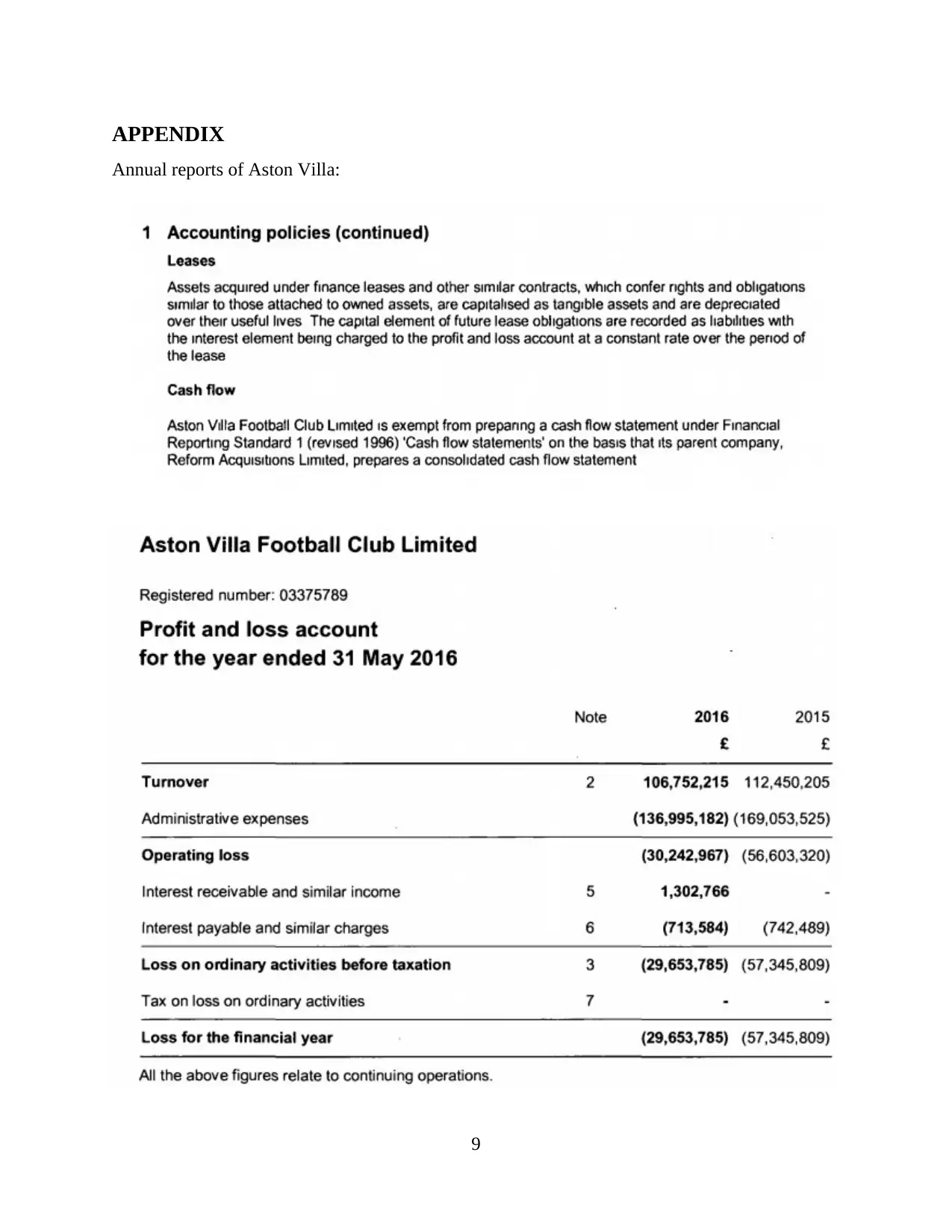
APPENDIX
Annual reports of Aston Villa:
9
Annual reports of Aston Villa:
9
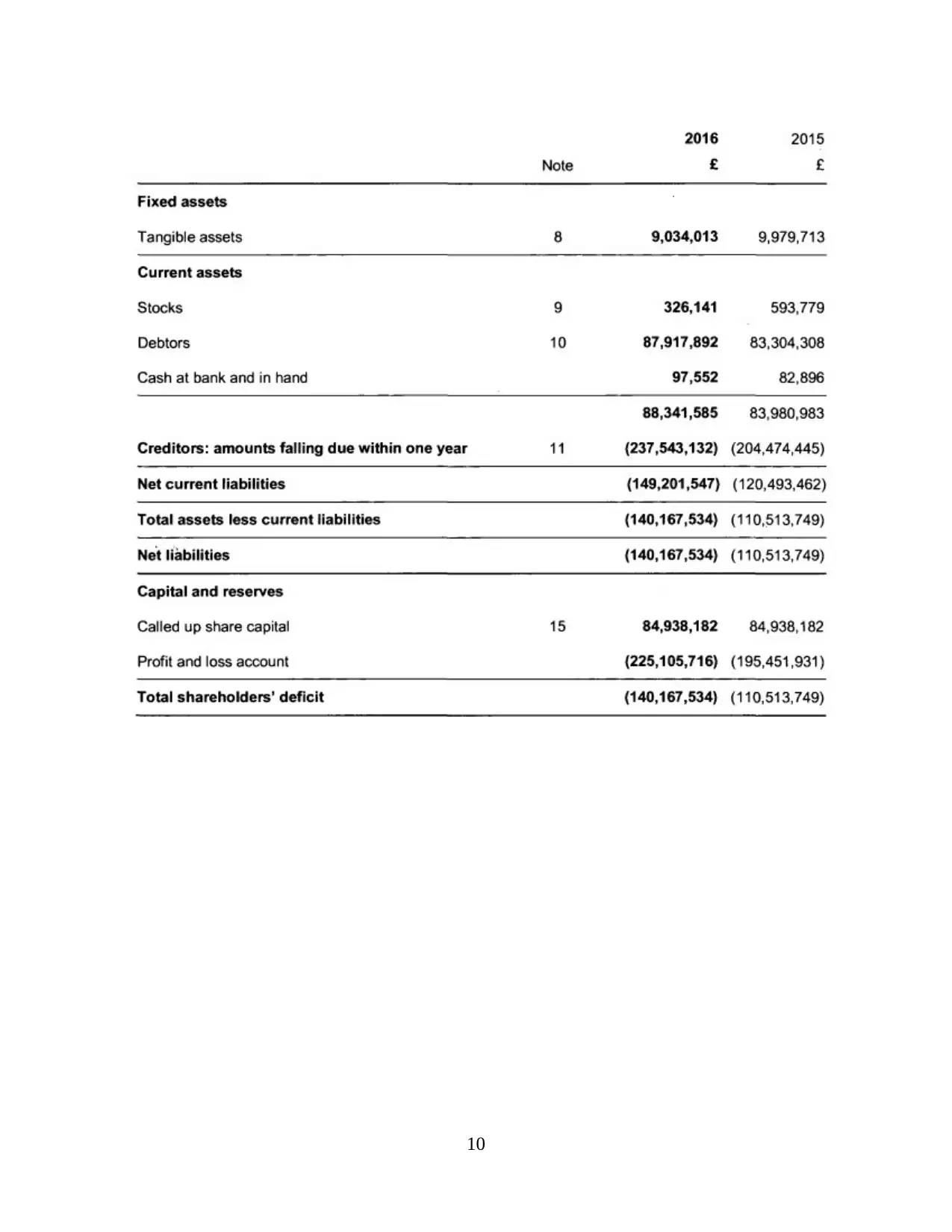
10
⊘ This is a preview!⊘
Do you want full access?
Subscribe today to unlock all pages.

Trusted by 1+ million students worldwide
1 out of 13
Related Documents
Your All-in-One AI-Powered Toolkit for Academic Success.
+13062052269
info@desklib.com
Available 24*7 on WhatsApp / Email
![[object Object]](/_next/static/media/star-bottom.7253800d.svg)
Unlock your academic potential
Copyright © 2020–2025 A2Z Services. All Rights Reserved. Developed and managed by ZUCOL.





